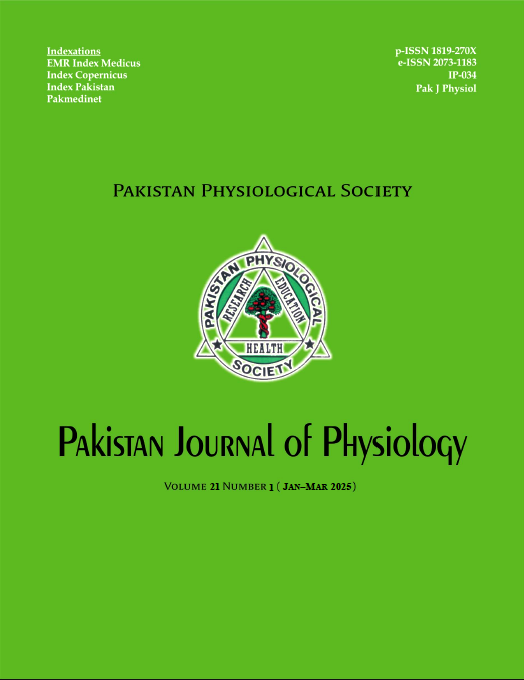HISTOPATHOLOGICAL SPECTRUM OF OVARIAN EPITHELIAL TUMOURS: A CROSS-SECTIONAL STUDY
DOI:
https://doi.org/10.69656/pjp.v25i1.1717Keywords:
Ovarian Cancer, Ovarian Epithelial Cancers, Histopathology, Benign, MalignantAbstract
Background: Ovarian cancer (OC) poses a significant health burden, ranking 8th in women’s cancers globally. Ovarian epithelial cancers (OEC) can present in a number of histopathologically distinct benign and malignant patterns. This study aims to assess the histopaythological characteristics of ovarian epithelial tumours in our local setting. Methods: This retrospective cross-sectional study, conducted at Ayub Medical College, Abbottabad, from Jan 2022 to Dec 2023, included 111 patients with histopathologically confirmed ovarian epithelial lesions. All biopsy records of OC during the study periods were retrieved and assessed for histopathological diagnosis. Confirmed cases of OEC were re-examined and included in the study. Records of patients’ associated demographic data were obtained from HMIS of Ayub Teaching Hospital. Data were analysed on SPSS-27. Results: The mean age at diagnosis was 53.44±10.52 years, with the majority (73, 65.8%) being multipara and having unilateral lesions. Serous cystadenoma emerged as the most prevalent (42, 37.8%) benign tumour, while serous carcinoma dominated (22, 19.8%) malignant cases. Family history emerged as a significant factor, with 60.5% of malignant cases having a positive family history (p<0.001). Stratification by age at diagnosis, menarche, and menopause revealed no statistically significant difference between benign and malignant lesions in all strata. Conclusions: Serous cystadenoma is the most common benign tumour while serous carcinoma is the most common ovarian epithelial malignancy in Hazara division. The predominance of serous cystadenoma and serous carcinoma underscores the need for further exploration of familial risk factors.
Pak J Physiol 2025;21(1):25–8, DOI: https://doi.org/10.69656/pjp.v21i1.1717
Downloads
References
Sung H, Ferlay J, Siegel RL, Laversanne M, Soerjomataram I, Jemal A, Bray F. Global cancer statistics 2020: GLOBOCAN estimates of incidence and mortality worldwide for 36 cancers in 185 countries. CA Cancer J Clin 2021;71(3):209–49.
Worldwide cancer data: World cancer research fund international [Internet]. 2022 [cited 2023 Nov 12]. Available from: https://www.wcrf.org/cancer-trends/worldwide-cancer-data
Arora T, Mullangi S, Lekkala MR. Ovarian Cancer. [Updated 2023 Jun 18]. In: StatPearls [Internet]. Treasure Island (FL): StatPearls Publishing; 2024. Available from: https://www.ncbi.nlm.nih.gov/books/NBK567760/
Momenimovahed Z, Tiznobaik A, Taheri S, Salehiniya H. Ovarian cancer in the world: epidemiology and risk factors, Int J Womens Health 2019;11:287–99.
Umakanthan S, Chattu VK, Kalloo S. Global epidemiology, risk factors, and histological types of ovarian cancers in Trinidad. J Family Med Prim Care 2019;8(3):1058–64.
Kumar V, Abbas A, Aster J, Ellenson LH, Pirog EC. The Female Genital Tract. In: Kumar V, Abbas A, Aster J, (Eds). Robbins & Cotran pathologic basis of disease. 10th ed. Philadelphia: Elsevier; 2019. p. 985–1036.
Devouassoux-Shisheboran M, Genestie C. Pathobiology of ovarian carcinomas. Chin J Cancer 2015;34(1):50–5.
Crosble EJ. Malignant Diseases of the Ovary. In: Bickerstaff H, Kenny LC, Myers JE, (Eds). Gynaecology by Ten Teachers. 20th ed. Boca Raton: CRC Press; 2017. pp. 193–203.
Elshami, M. Tuffaha A, Yaseen A, Alser M, Al-Slaibi I, Jabr H, Ubaiat S, et al. Awareness of ovarian cancer risk and protective factors: A national cross-sectional study from Palestine. PLoS One 2022;17(3):e0265452.
Ali AT, Al-Ani O, Al-Ani F. Epidemiology and risk factors for ovarian cancer. Prz Menopauzalny 2023;22(2):93–104.
Whelan E, Kalliala I, Semertzidou A, Raglan O, Bowden S, Kechagias K, et al. Risk factors for ovarian cancer: An umbrella review of the literature. Cancers (Basel) 2022;14(11):2708.
Pillay L, Wadee R. A retrospective study of the epidemiology and histological subtypes of ovarian epithelial neoplasms at Charlotte Maxeke Johannesburg Academic Hospital. South Afr J Gynaecol Oncol 2021;13(1):26–35.
Mehra P, Aditi S, Prasad KM, Bariar NK. Histomorphological analysis of ovarian neoplasms according to the 2020 WHO classification of ovarian tumors: A distribution pattern in a tertiary care center. Cureus 2023;15(4):e38273.
Farag NH, Alsaggaf ZH, Bamardouf NO, Khesfaty DM, Fatani MM, Alghamdi MK, et al. The histopathological patterns of ovarian neoplasms in different age groups: A retrospective study in a tertiary care center. Cureus 2022;14(12):e33092.
Mondal SK, Bhattacharya, S, Mandal S1; Panda UK. Histological spectrum, bilaterality, and clinical evaluation of ovarian lesions –A 10-year study in a rural tertiary hospital of India. Indian J Health Sci Biomed Res (KLEU) 2020;13:28–31.
Zheng G, Yu H, Kanerva A. Försti A, Sundquist K, Hemminki K. Familial ovarian cancer clusters with other cancers. Sci Rep 2018;8(1):11561.
Torre LA, Trabert B, DeSantis CE, Miller KD, Samimi G, Runowicz CD, et al. Ovarian cancer statistics, 2018. CA Cancer J Clin 2018;68(4):284–96.
Coburn SB, Bray F, Sherman ME, Trabert B. International patterns and trends in ovarian cancer incidence, overall and by histologic subtype. Int J Cancer 2017;140(11):2451–60.
Zheng G, Yu H, Kanerva A, Försti A, Sundquist K, Hemminki K. Familial risks of ovarian cancer by age at diagnosis, proband type and histology. PLoS One 2018;13(10):e0205000. Erratum in: PLoS One 2018;13(10):e0206721.
Bethea TN, Ochs-Balcom HM, Bandera EV, Beeghly-Fadiel A, Camacho F, Chyn D, et al. First- and second-degree family history of ovarian and breast cancer in relation to risk of invasive ovarian cancer in African American and white women. Int J Cancer 2021;148(12):2964–73.
Downloads
Published
How to Cite
Issue
Section
License
Copyright (c) 2025 Sidra Maqbool Khan, Muhammad Tariq, Shagufta Naeem, Syed Meesam Mehdi, Anila Riyaz, Fouzia Jehangir

This work is licensed under a Creative Commons Attribution-NoDerivatives 4.0 International License.
The author(s) retain the copyrights and allow their publication in Pakistan Journal of Physiology, Pak J Physiol, PJP to be FREE for research and academic purposes. It can be downloaded and stored, printed, presented, projected, cited and quoted with full reference of, and acknowledgement to the author(s) and the PJP. The contents are published with an international CC-BY-ND-4.0 License.











